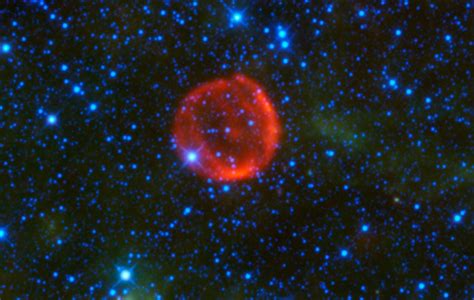In 1572, people across the northern hemisphere saw a star appear in the constellation Cassiopeia.
1572年,北半球的很多人看到一颗恒星出现在仙后座中。
It quickly grew brighter than Venus, and for two weeks, you could even see it during the day.
这颗恒星很快就变得比进行还要耀眼。有那么2周的时间里,就连白天都看得到它。
After about 18 months, the new star faded away.
大概18个月后,这颗新出现的恒星却消失了。
Of course, we now know it wasn't really a new star.
当然了,我们现在已经知道它并不算是新恒星了。

It was an old star, 13,000 light-years away, exploding as a supernova.
它是一颗有资历的恒星,距离我们有1.3万光年的距离,并已经以超新星的方式爆炸了。
It's now known as Tycho's supernova, after the famous astronomer who tracked its progress.
现在,我们称它为第谷超新星,这个名字是以跟踪它发展进程的天文学家命名的。
Today, all that's left of the explosion is an expanding cloud of leftover gas and dust.
如今,它以超新星方式爆炸后留下的只有一个逐渐扩大的云团,里面都是它遗留的气体和灰尘。
But in 2008, modern-day astronomers got a rare opportunity to see a rerun of the main event, when a second pulse of light reached Earth.
但2008年的时候,现代的一些天文学家得到了一次罕见的机会,他们看到了第二次大事件重演——第二缕光抵达地球。
These kinds of repeat signals are known as light echoes.
这类重复信号就是光回声。
We've seen them from a few different types of bright flashes in space, but most of the ones we've spotted have come from supernovas.
我们在宇宙中看到过多种不同类型的闪光,但其中大多数都来自于超新星。
And by studying them, astronomers have been able to resolve some decades-old questions about what happens when stars explode.
通过研究超新星,天文学家得以解决了萦绕几十年的诸多问题,这些问题都与恒星爆炸的情况有关。
Light echoes work a lot like regular echoes, the kind you hear when sound bounces off a surface like a wall or a cliff.
回光的机理与常规的回声十分相似。所谓回声,就是我们声音触墙表或者绝壁表面后反弹的现象。
Light waves can also bounce, but over Earth-sized distances, it's virtually impossible to notice the delay from bouncing light without special equipment because the speed of light is just too fast.
光波也会反弹,但是在地球大小的距离上反弹,如果没有特殊的设备,是不几乎不可能看到反弹的光波的,因为光速太快了。
But, when light reflects off something light-years away from the original source, like a cloud of dust, the delay can amount to years.
但当光从距离几光年的原始来源(比如尘土)发生反射时,延时可能长达数年之久。
That's exactly what happened in the case of Tycho's supernova.
第谷超新星就是这样。
The more recent pulse came from the same explosion we saw in 1572, but instead of traveling straight to Earth, it left the star and hit some dust clouds at just the right angle to bounce back toward Earth.
最近的一次脉冲来自于1572年的同一场爆炸。但这一次并未径直来到地球,而是在离开恒星后,击中了一些尘云,然后,由于角度适当,所以又反弹回了地球。
The detour added 436 years to its journey.
这次绕道而行让它多用了436年的时间才完成了整个旅程。
It's hard to predict exactly when and where a supernova's light echoes will happen,
很难精确预测一颗超新星的光在何时何地发出,
but when conditions are right, they appear like fuzzy arcs around the spot where stars have exploded in the past.
但条件满足的时候,超新星的光就会在之前发生爆炸的恒星附近的弧度处产生。
Once we find them, light echoes can tell us all kinds of secrets about the supernovas they come from.
我们发现之后,回光就能告诉我们有关它们所来自超新星的所有秘密。
For one thing, they give us multiple chances to experience the same phenomenon.
一方面,它们让我们有了许多能够体验同一现象的机会。
Normally, when we study supernovas, we're only ever looking at a tiny slice of the entire process.
正常情况下,我们在研究超新星的时候,只能看到整个进程中很小的一部分。
Even if we catch a supernova right as it's exploding, after it fades, it can take hundreds of years before the remnant spreads wide enough for our telescopes to resolve it.
即便我们在恒星爆炸的时候能够恰好看到超新星的光,但它消散后,需要等上几百年的时间,残留物发出的光才能被望远镜看到,然后问题才能解决。
It's like trying to figure out the plot of an entire movie by watching just a few seconds.
就好像通过几秒钟的影片来弄清楚一部电影的所有情节一样。
But with light echoes, scientists can examine the same supernova at two different times in its life.
但有了回光之后,科学家就能对同一个超新星的生命周期进行2次不同的观测。
With Tycho's supernova, for example, researchers used the light echoes to study the explosion itself and compared it with what we can see of the supernova's aftermath.
比如,在第谷超新星的帮助下,研究人员通过回光来研究爆炸本身,并将其与第谷超新星余波后的景象进行对比。
With the new data, they were able to confirm what type of supernova it was, which astronomers had been debating for decades.
用同样的数据,我们还能确认超新星的类型,这一点是天文学家讨论过几十年的问题了。
Turns out that it was one of the most common: a Type Ia.
最后,我们发现,它属于最常见的Ia超新星。
Astronomers think Ia supernovas happen when the gravity from a white dwarf, which is a super dense star, either pulls in material from a second star in the same system, or merges with another white dwarf in the same system.
天文学家认为Ia超新星发生的条件是:白矮星(密度极高的恒星)通过来吸引同一个系统中的另一颗恒星,或者通过引力与同一系统中的另一颗白矮星聚合在一起。
Either way, once the white dwarf absorbs a certain amount of mass, it explodes.
无论是哪一种情形,一旦白矮星吸收了一定的质量,它就会发生爆炸。
Light echoes can also give us 3D vision. We usually only see light that's emitted from the supernova in one direction: toward us.
回光也可以让我们了解三维的视角。通常情况下,我们只能从一个方向观测到超新星释放出来的光:朝向地球的方向。
But, if dust is oriented just right, it can reflect light coming from different parts of the star.
但如果灰尘的方向恰到好处,那么这缕光可以反射出从恒星不同部分发出的光。
In 2011, astronomers used light echoes bouncing off three different clouds of dust to get a 3D picture of the supernova Cassiopeia A, which appeared in the sky around 300 years ago.
2011年,天文学家通过从3个尘云发出的回光获得了超新星——仙后座A源的三维图像。仙后座A源大概300年前就出现在天空中了。
We'd known for a while that the leftovers of the explosion looked pretty lopsided.
我们已经知道,超新星爆炸的残留物不太平衡。
But it's always hard to know if a supernova's asymmetry came from the explosion itself, or if it happened later, as the debris passed through space.
但很难知道超新星的这种不对称是来自于爆炸期间,还是爆炸之后,因为残骸散布于宇宙各处。
We're still not totally sure how Cassiopeia A got so lopsided, but the light echoes showed a bunch of asymmetry right around the time of the supernova, which means it might have happened during the explosion itself.
我们还不太确定仙后座A源为何如此不对称,但回光显示,超新星爆炸发生时,有一缕不对称的光出现。这就是说,可能是在爆炸期间发生的。
You can use light echoes to see what the space around a supernova is like, too.
可以通过回光来判断超新星附近的空间是什么样子。
It's basically echolocation, except instead of bats bouncing sound waves off of their surroundings, there are enormous explosions bouncing light.
基本上是回波定位,除了蝙蝠通过声波来判断周围环境的情况,因为有很多爆炸都能反射光源。
Based on where the light echoes are coming from, we can tell where the dust is and how it's oriented.
根据回光的来源位置,我们可以判断尘土的位置以及其朝向。
We can even measure its thickness based on how sharp or blurry the reflection is.
我们甚至可以测量出它的厚度,根据就是反射的清晰程度。
And the color of the light can give us some clues about what type of dust it's bouncing off of.
通过光的颜色,我们可以获得其反射尘土的类型。
In each rerun we watch through a light echo, we get a new perspective and a new chance to explore the past with better instruments and more knowledge.
在每次反射中,我们可以通过回光获得新的视角,也有新的机会可以探索过去,因为我们有了更好的设备和更全面的知识。
And from these echoes, we can learn more than we would from just one look.
通过回光,我们可以比只看一次了解的更多。
Thanks for watching this episode of SciShow Space!
感谢收看本期的《太空科学秀》!
If huge explosions in space are your thing, you might want to check out our video about how astronomers accidentally discovered the biggest explosions we've ever seen in the universe: gamma ray bursts.
如果您对宇宙中的爆炸感兴趣,那么您可能想观看我们有关天文学家无意中发现大型爆炸——伽马射线暴的视频。


